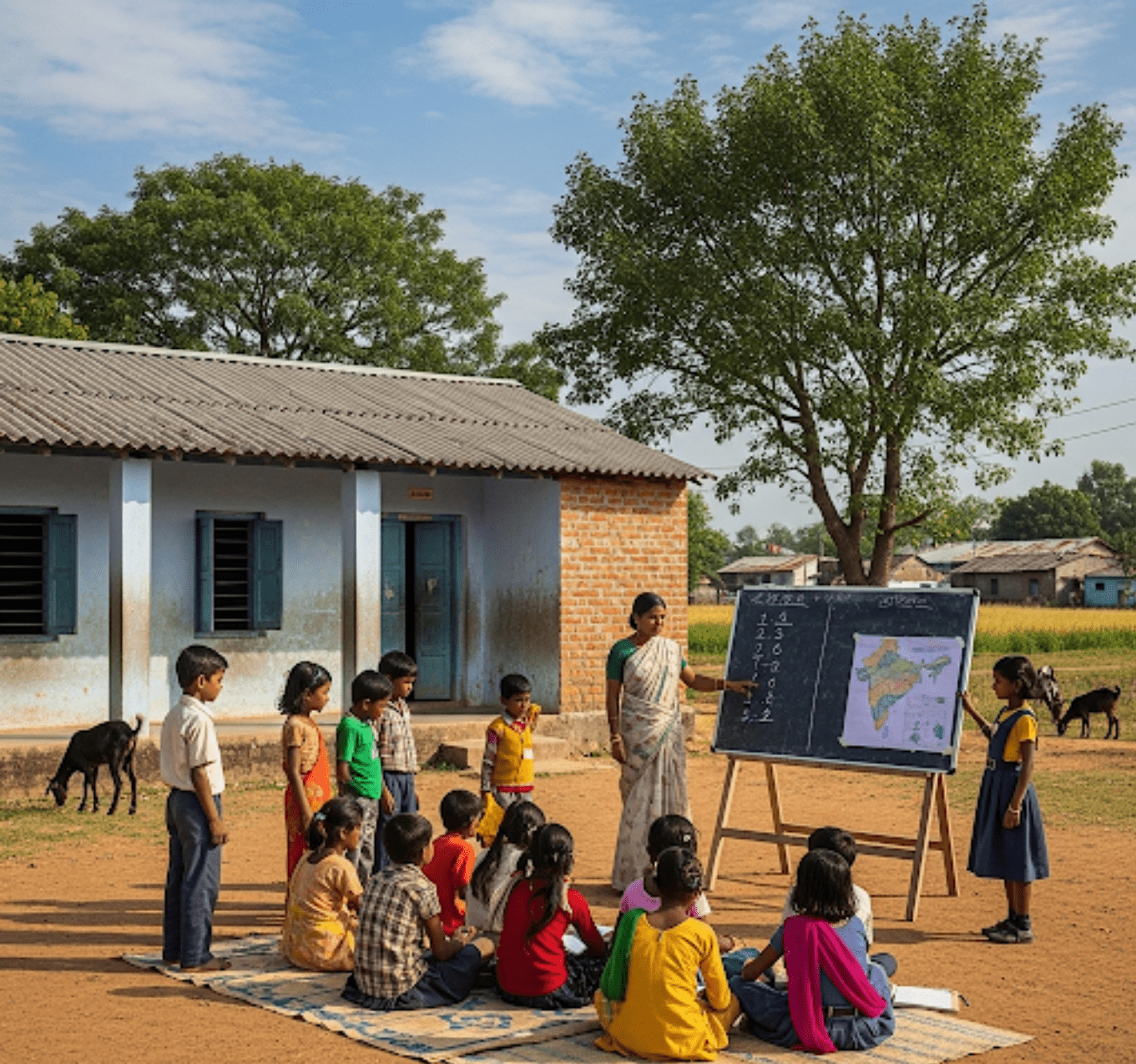India’s rural communities possess tremendous potential, with eager young minds ready to learn and rich cultural traditions that value knowledge. However, a persistent educational divide threatens to limit opportunities for millions of children. Amid all of this promise, there is one stark reality: a long-standing educational gap.
Rural students continue to face outdated textbooks, poor infrastructure, and a shortage of qualified teachers. You can make a difference by taking steps to reduce education disparities in rural India.
Why Rural India’s Education is Falling Behind
Rural India’s educational system is in decline due to a mix of social and systemic factors. Many schools are lacking basic infrastructure, such as clean toilets and sufficient lighting. The classrooms are also uninspiring. Lack of qualified teachers exacerbates the problem. Unfilled vacancies and high absence rates are common.
Families in rural areas are often forced to make difficult financial decisions, which can force their children to choose between work and school. Students also have language problems because the textbooks are either in Hindi or English, and they speak their dialects. As the digital divide widens, students are increasingly isolated from modern educational tools and opportunities.
Infrastructure Drought
You may find cracked walls or ceilings with leaks or even a classroom that lacks fans or lighting. Without proper infrastructure, education becomes significantly more challenging, hindering both learning outcomes and regular attendance. This not only hampers learning but also discourages girls from attending school regularly
Teachers Shortage & Missed Classrooms
A lack of well-trained and motivated teachers is another pressing issue. In many remote areas, there are vacancies for teacher positions, or the ones hired are not qualified. Students experience disrupted learning continuity, resulting in slower academic progress
Child Labor & Economic Pressures
In rural households, children are seen as a means of earning money. School is put on hold when there’s work to be done. One day missed in class could mean a lifetime of opportunities.
Language and Learning Barriers
In villages, children usually speak the local dialect at home. The school curriculum is usually in Hindi or English, which the children cannot fully understand. It creates a communication gap, but also a lack of motivation and confidence.
Growing Digital Divide
Urban students are now learning through smartboards, videos, and online platforms. Rural children are left out of digital education. It’s not just about access to technology; it’s also about future preparedness. Rural students are left behind in a digitally driven job market if they don’t have access to technology.
Why Your Donation Can Make a Difference
Every dollar can make a difference. Donations to verified educational NGOs will directly impact the quality of education for India’s most underserved regions.
Here are some ways your contribution can make a real difference:
- Build and Restore Schools: Improve basic infrastructure walls, toilets, fans, and safe drinking water.
- Give rural classrooms digital tools: Tablets, projectors, and offline learning modules are available for rural classrooms.
- Support Teachers: Provide training and salary to high-quality teachers.
- Sponsor a Child’s Needs: Help cover the cost of uniforms, books, and healthy meals for children so they can concentrate on their studies.
Supporting established rural education organizations like vidyalaya.org is more than just a donation of money. You’re also giving the gift of opportunity.
Donations that Turn into Action
The most effective way to support rural education is in partnership with local organizations that understand the needs of the area. Vidyalaya.org can play a crucial role in this regard.
- Partner with impact-driven NGOs. Understand local barriers and collaborate with them directly.
- Select Specific Projects. Want to fund a school library, teacher salaries, or girls’ scholarships? You can choose the projects you want to fund on platforms like vidyalaya.org.
- Volunteer or mentor: Your time and professional skills will make an impact, even if you cannot contribute financially.
Real Impact: What Research Shows
According to studies by organizations like Pratham and government data, targeted educational interventions have shown measurable results.
Infrastructure improvements combined with teacher training can increase student engagement and learning outcomes significantly when implemented systematically over time
Rural Education has a ripple effect
Rural education has many benefits that extend beyond the classroom.
- Community Upliftment: Educated children become informed community leaders and change makers.
- Economic Growth: Better job prospects and higher earnings are linked to literacy and basic skills.
- Empowered Girls—Education can delay early marriages and encourage financial independence in girls.
- Literate parents prioritize education and start a cycle that will last generations.
Your Call to Action
It’s not just about buying tablets or funding buildings. It’s all about restoring hope, restoring self-confidence, and enabling dreams.
Donating to platforms such as vidyalaya.org is a great way for you to:
- Investing in the futures of the most vulnerable children
- Empowering Communities to Lift Themselves Through Education
- Helping India bridge its education divide, one village at a time
Your contribution, no matter how small, can change lives. Today is the day to take action. Because your donation doesn’t just support education—it inspires transformation.
Final Thoughts
Rural India is not lacking in intelligence or ambition, but it lacks opportunity. Here’s where you can assist. Each step, whether you’re funding a toilet or training a teacher, will bring a child closer to a brighter future. Your efforts will be directed to the most needy areas with a platform such as vidyalaya.org.
FAQs on Facing Rural Education Challenges in India
1. Why is rural India experiencing such high levels of education inequality?
Rural areas still have a poor quality of education because of a lack in school infrastructure, fewer teachers available, social and economic pressures, as well as the digital divide.
2. What is the cost of adopting a rural school?
The cost can range from Rs 1 lakh up to Rs 5 lakh, depending on the location and type of project. Many websites like vidyalaya.org offer transparent breakdowns of each initiative.
3. Can rural education donations be tax-deductible?
Donations made to NGOs that are registered according to Section 8OG can be deducted from your taxes. This is a great way to both save money and make a monetary donation.
4. What is the impact of digital tools on rural education?
Digital tools can help students overcome their comprehension gaps, get them involved in learning, and prepare them for a technology-driven world, especially if they are introduced through structured platforms like vidyalaya.org.

